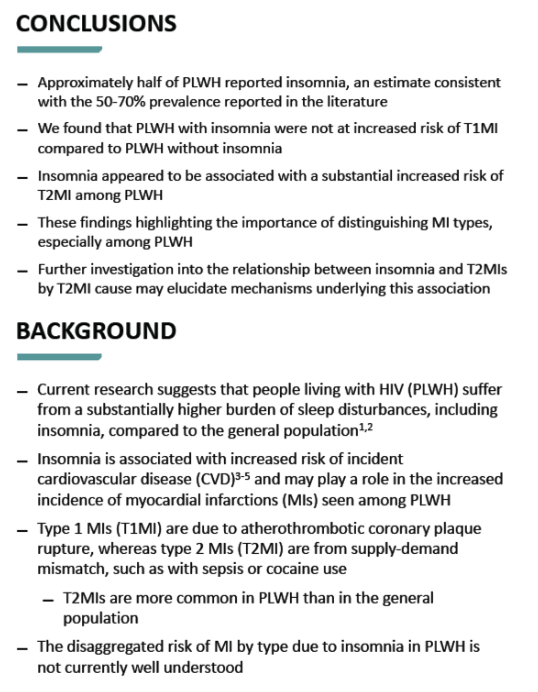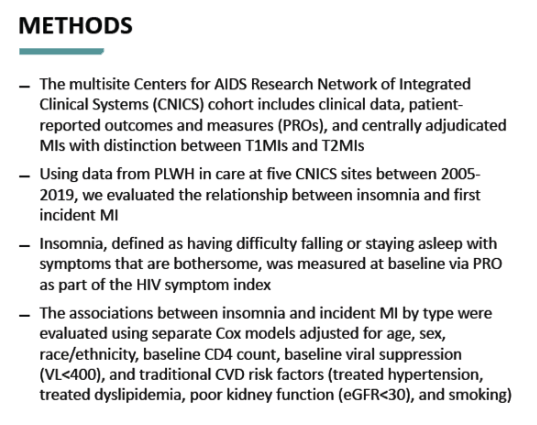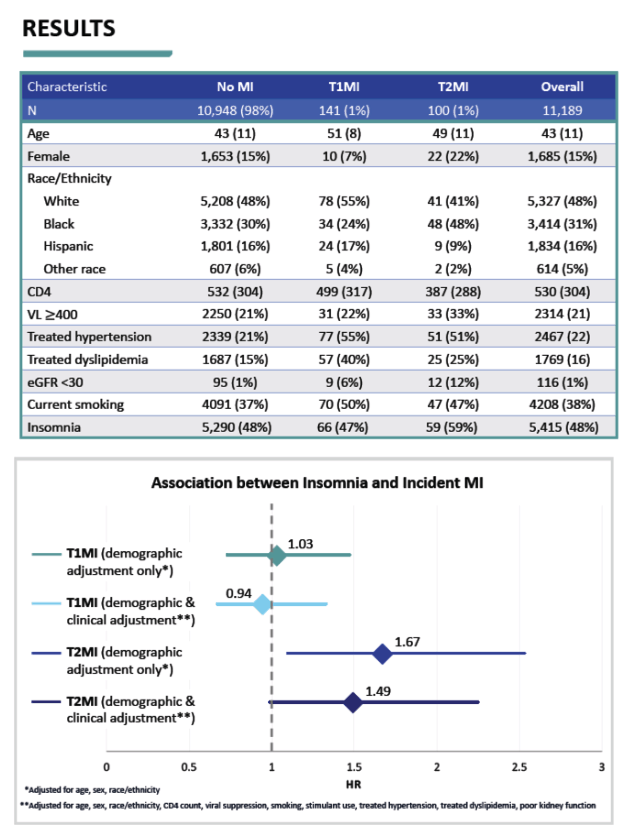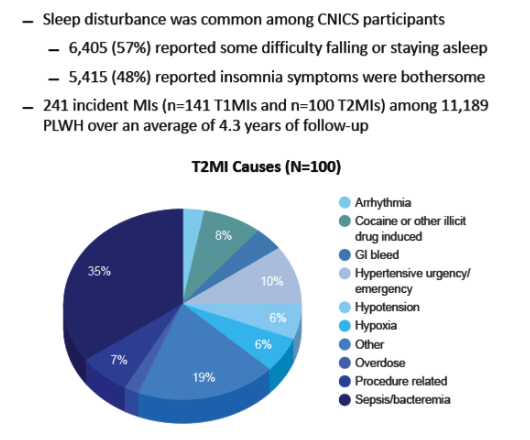 |
 |
 |
| |
INSOMNIA AND RISK OF INCIDENT MYOCARDIAL INFARCTION AMONG
PEOPLE LIVING WITH HIV
|
| |
| |
CROI 2020 March 8-11
Reported by Jules Levin
Bridget M. Whitney1, Robin M. Nance1, Joseph Delaney2, Stephanie A. Ruderman1, Matthew Budoff3, W. C. Mathews4, Richard D. Moore5, Matthew Feinstein6, Greer Burkholder7,
Michael J. Mugavero7, Joseph J. Eron8, Michael Saag7, Mari M. Kitahata1, Heidi M. Crane1, for the CNICS Cohort
1University of Washington, Seattle, WA, USA; 2University of Manitoba, Winnipeg, MB, Canada; 3University of California Los Angeles, Los Angeles, CA, USA; 4University of California San Diego, San Diego, CA, USA; 5Johns Hopkins University, Baltimore, MD, USA; 6Northwestern University, Chicago, IL, USA;
7University of Alabama at Birmingham, Birmingham, AL, USA; 8University of North Carolina at Chapel Hill, Chapel Hill, NC, USA
(57%) PLWH reporting some difficulty falling or staying asleep and 5,415 (48%) PLWH reporting their insomnia symptoms were bothersome. ....PLWH experiencing insomnia were 53% more likely to have an incident T2MI compared to PLWH without insomnia (Hazard Ratio (HR)=1.53, 95% confidence interval (CI): 1.02-2.29; p=0.04). T1MI was not associated with insomnia (HR=0.95, 95%CI: 0.67-1.32; p=0.75)...... type 2 MIs (T2MI) are from supply-demand mismatch, such as with sepsis or cocaine use; T2MIs are more common in PLWH than in the general population....Type 1 MIs (T1MI) are due to atherothrombotic coronary plaque rupture
CROI 2020 March 8-11
Reported by Jules Levin
Bridget M. Whitney1, Robin M. Nance1, Joseph Delaney2, Stephanie A. Ruderman1, Matthew Budoff3, W. C. Mathews4, Richard D. Moore5, Matthew Feinstein6, Greer Burkholder7, Michael J. Mugavero7, Joseph J. Eron8, Michael Saag7, Mari M. Kitahata1, Heidi M. Crane1, for the CNICS Cohort
1University of Washington, Seattle, WA, USA; 2University of Manitoba, Winnipeg, MB, Canada; 3University of California Los Angeles, Los Angeles, CA, USA; 4University of California San Diego, San Diego, CA, USA; 5Johns Hopkins University, Baltimore, MD, USA; 6Northwestern University, Chicago, IL, USA; 7University of Alabama at Birmingham, Birmingham, AL, USA; 8University of North Carolina at Chapel Hill, Chapel Hill, NC, USA
program abstract
INSOMNIA AND RISK OF INCIDENT MYOCARDIAL INFARCTION AMONG PEOPLE LIVING WITH HIV
Background: Current research suggests that people living with HIV (PLWH) suffer from a substantially higher burden of sleep disturbances, including insomnia, compared to the general population. Insomnia is associated with increased risk of cardiovascular disease (CVD) and may play a role in the increased incidence of myocardial infarctions (MIs) seen among PLWH. Type 1 MIs (T1MI) are due to atherothrombotic coronary plaque rupture, whereas type 2 MIs (T2MI) are from supply-demand mismatch, such as with sepsis or cocaine use; T2MIs are more common in PLWH than in the general population. The disaggregated risk of MI by type due to insomnia in PLWH is unknown.
Methods: The multisite Centers for AIDS Research Network of Integrated Clinical Systems (CNICS) cohort includes clinical data, patient-reported outcomes and measures (PROs), and centrally adjudicated MIs with distinction between T1MIs and T2MIs. Using data from PLWH in care at 5 CNICS sites between 2005-2019 we evaluated the relationship between insomnia and first incident MI. Insomnia, defined as having difficulty falling or staying asleep with symptoms that are bothersome, was measured at baseline via PRO as part of the HIV symptom index. The associations between insomnia and incident MI by type were evaluated using separate Cox models adjusted for age, sex, race/ethnicity, CD4 count, viral suppression (VL<400), and traditional CVD risk factors, including treated hypertension, treated dyslipidemia, kidney function (eGFR<30), and smoking.
Results: Among 11,189 PLWH there were 241 incident MIs (n=141 T1MIs and n=100 T2MIs) over an average of 4.3 years of follow-up.
Sleep disturbance was common, with 6,405 (57%) PLWH reporting some difficulty falling or staying asleep and 5,415 (48%) PLWH reporting their insomnia symptoms were bothersome.
In adjusted analyses, PLWH experiencing insomnia were 53% more likely to have an incident T2MI compared to PLWH without insomnia (Hazard Ratio (HR)=1.53, 95% confidence interval (CI): 1.02-2.29; p=0.04). T1MI was not associated with insomnia (HR=0.95, 95%CI: 0.67-1.32; p=0.75).
Conclusion: Approximately half of PLWH reported insomnia, an estimate consistent with the 50-70% prevalence reported in the literature. We found that PLWH with insomnia had a substantial increased risk of T2MI, but not T1MI, highlighting the importance of distinguishing MI types. Further investigation into the relationship between insomnia and T2MIs by T2MI cause may elucidate mechanisms underlying this association.




References: 1. Taibi DM. Sleep disturbances in persons living with HIV. J Assoc Nurses AIDS Care. 2013 Jan; 24(1 Suppl): S72-S85. 2. Ren J, et al. Factors associated with sleep quality in HIV. J Assoc Nurses AIDS Care. 2018 Nov - Dec;29(6):924-931. 3. Polanka BM, et al. Insomnia as an independent predictor of incident cardiovascular disease in HIV: data from the Veterans Aging Cohort Study. J Acquir Immune Defic Syndr. 2019 May 1;81(1):110-117. 4. Javaheri S, Redline S. Insomnia and risk of cardiovascular disease. Chest. 2017 Aug; 152(2): 435-444. 5. Sofi F, et al. Insomnia and risk of cardiovascular disease: a meta-analysis. Eur J Prev Cardiol. 2014 Jan;21(1):57-64.
|
| |
|
 |
 |
|
|